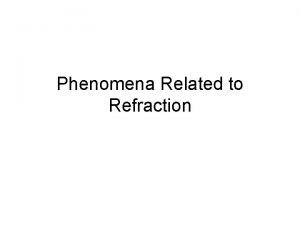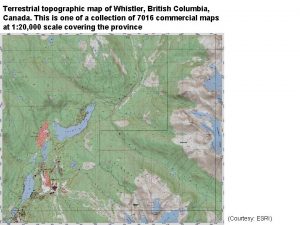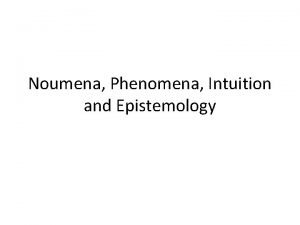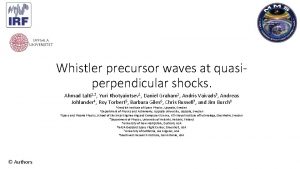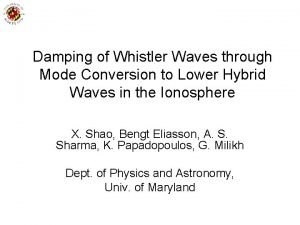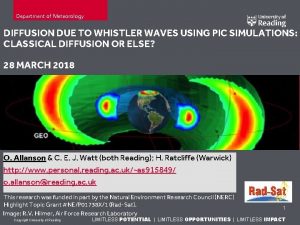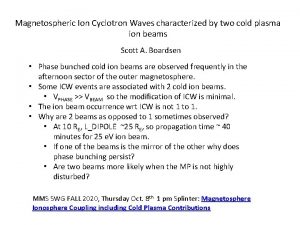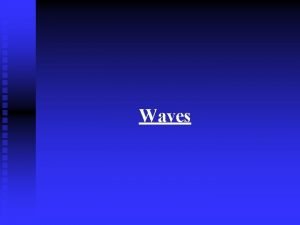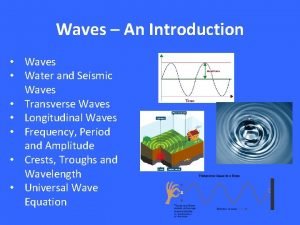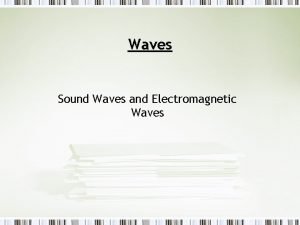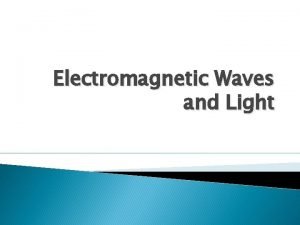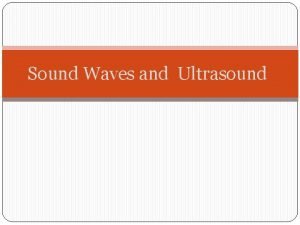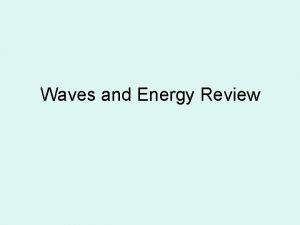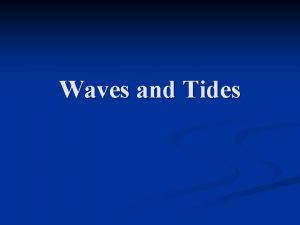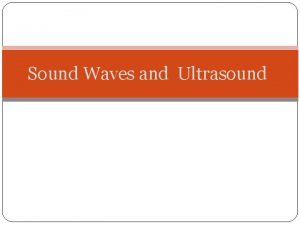Whistler Waves and Related Magnetospheric Phenomena Denys Piddyachiy























- Slides: 23

Whistler Waves and Related Magnetospheric Phenomena Denys Piddyachiy Space, Telecommunications and Radioscience Laboratory Stanford University, Stanford, CA 13 February 2007 PHYS 312 Basic Plasma Physics

Outline § § What is whistler? Examples Mechanism of whistler waves formation Whistler propagation in magnetosphere: § ducted whistlers § magnetospherically reflected whistlers § Interaction of whistler waves with energetic particles from Earth’s radiation belts § References

Whistler! What is this!? From Merriam-Webster whis·tler § a : any of various birds; especially : any of numerous oscine birds (especially genus Pachycephala) found chiefly in Australia and South Pacific islands and having a whistling call § b : a large marmot (Marmota caligata) of northwestern North America having a shrill alarm call § c : a broken-winded horse § d : a very-low-frequency radio signal that is generated by lightning discharge, travels along the earth's magnetic-field lines, and produces a sound resembling a whistle of descending pitch in radio receivers Example of a whistler recorded at Palmer Station, Antarctica

Just another example of whistlers f, k. Hz

Region of interest (filled with plasma)

Region of interest (filled with plasma)

Lightning-generated signal Very good conductors in ELF/VLF range (300 Hz - 30 k. Hz)

Whistler wave propagation in the magnetosphere

Multi-hop whistlers (Palmer Station, Antarctica)

Multi-hop whistlers (Palmer Station, Antarctica)

First order approximation of whistler wave propagation Refractive index or dispersion relation: Group velocity: Group delay:

Whistlers aboard a satellite

Magnetospherically reflected (MR) whistlers

Magnetospherically reflected vs. ducted whistlers Hey, dude, what is going on here? I am a physicist. I want an explanation.

Theoretical background Ray tracing: Refractive index: use B field and electron density models

Refractive index surfaces Fig. Refractive index surface indicating the resonance cone angle θres. Expanded section shows the refractive index at an angle θ with associated ray direction.

Modeling of MR whistlers

Earth’s radiation belts

Lightning (whistler) induced electron precipitation § Basic physics of Lightning-induced Electron Precipitation (LEP): § 1) Lightning discharges produce intense electromagnetic radiation in very low frequency (VLF) range. § 2) The VLF waves enter into the magnetosphere where they propagate almost along B-field lines to a region near the magnetic equator. § 3) In the equatorial region VLF waves can effectively interact with energetic electrons from the radiation belts which leads to the scattering of electrons, i. e. changing of their pitch angles distribution if this condition is satisfied: ωCe = ω – k║ v║ § 4) The change of the pitch angles leads to lowering of electrons reflection points in their bounce motion between conjugate ionospheres and as a consequence to their precipitation into the atmosphere.

Lightning-induced precipitation detection aboard low earth orbit satellite DEMETER

Adiabatic motion of electrons in radiation belts

Mechanism of electron precipitation by whistler waves

References § § § § Helliwell, R. A. , Whistlers and related ionospheric phenomena, Stanford University Press, Stanford, Calif. , 1965. Kivelson, M. G. , and C. T. Russel, Introduction to spacephysics, Cambridge University Press, 1995. Spasojevic, M. , Global Dynamics of the Earth's Plasmasphere, Stanford Univ. , Ph. D thesis, 2003. Bortnik, J. , Precipitation of Radiation Belt Electrons by Lightning-Generated Magnetospherically Reflecting Whistler Waves, Stanford Univ. , Ph. D thesis, 2004. Burgess, W. C. , Lightning-Induced Coupling of the Radiation Belts to Geomagnetically Conjugate Ionospheric Regions, Stanford Univ. , Ph. D thesis, 1993. Carpenter, D. L. , Remote sensing the Earth’s plasmasphere, Rad. Sci. Bull, 2004. Inan, U. S. , D. Piddyachiy, W. B. Peter, J. A. Savaud, M. Parrot, DEMETER Satellite observations of lightning-induced electron precipitation bursts, Geophysical Research Letters (under review), 2007. Ph. D theses and other related information could be found at http: //wwwstar. stanford. edu/~vlf/
 Denys poshyvanyk
Denys poshyvanyk Phenomena related to refraction of light
Phenomena related to refraction of light Whistler gis map
Whistler gis map Compare and contrast p waves and s waves using venn diagram
Compare and contrast p waves and s waves using venn diagram Physical fitness two types
Physical fitness two types Health-related skills
Health-related skills Differences between mechanical and electromagnetic waves
Differences between mechanical and electromagnetic waves Example of mechanical waves
Example of mechanical waves How are rainbows made
How are rainbows made Short wave vs long wave radiation
Short wave vs long wave radiation Difference between matter waves and electromagnetic waves
Difference between matter waves and electromagnetic waves Mechanical and electromagnetic waves similarities
Mechanical and electromagnetic waves similarities Seismic waves
Seismic waves Mechanical waves and electromagnetic waves venn diagram
Mechanical waves and electromagnetic waves venn diagram Difference between constructive and destructive waves
Difference between constructive and destructive waves Sound waves are mechanical waves true or false
Sound waves are mechanical waves true or false Characteristics of a longitudinal wave
Characteristics of a longitudinal wave Is echolocation transverse or longitudinal
Is echolocation transverse or longitudinal Mechanical vs electromagnetic
Mechanical vs electromagnetic Is a seismic wave mechanical or electromagnetic
Is a seismic wave mechanical or electromagnetic Physical and chemical phenomena
Physical and chemical phenomena Examples of colloids
Examples of colloids Surface and interfacial phenomena
Surface and interfacial phenomena Noumenon
Noumenon

